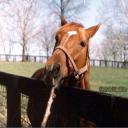Yahoo Answers is shutting down on May 4th, 2021 (Eastern Time) and beginning April 20th, 2021 (Eastern Time) the Yahoo Answers website will be in read-only mode. There will be no changes to other Yahoo properties or services, or your Yahoo account. You can find more information about the Yahoo Answers shutdown and how to download your data on this help page.
Trending News
Do you think O'Neill trained IHA too hard for the Belmont?
Maybe if he had galloped him less he wouldn't have become injured?
9 Answers
- Anonymous9 years agoFavorite Answer
NO!
- Starlight 1Lv 79 years ago
Bowed tendons ( aka "tendonitis") are a very common problem in horses that do a lot of work at high speeds. A simple bad step or a slip can cause them, and when they happen, there's not a whole lot that you can do except stop the horse from causing further damage by limiting the animal's activity. Tendons are like rubber bands in the sense that they can get over or hyper extended very easily, and when this happens, the rubber band almost never regains its former shape or elasticity. Tendons in a horse's legs function much the same way. Once they become hyper extended, however, they almost never regain their former shape or strength, even with treatment and rest. THAT was why O'Neil had to make the decision he did. Even with the best of treatment, an injury like that can take upwards of a year or more to heal- and there would never be any guarantee that the leg would be strong enough to stand up to the rigors of race training. No, O'Neil and the horse's owner made the right choice, painful though this was for them. IHA is worth FAR MORE as a stallion than he ever will be as a race horse. He has the potential to make MILLIONS for his owner- first in syndication deals, and then later from the sales of foals and the prize money which his offspring will win. Why would the owner take the chance on having the horse break down catastrophically ( which could happen if he ever attempted to race again after an injury like this) when there is so much money to be made by simply retiring him and sending him to the breeding shed? It makes no sense.
As for whether or not O'Neil trained the horse too hard, I don't think so. One of the more aggravating things about an injury like this is that they are so insidious and hard to predict. This came on suddenly, the way most bows generally do, and simply not galloping the horse for a day or two wouldn't have prevented what happened. I've worked with horses that had and have bows in their legs, and believe me, it's very possible for a horse to be perfectly fine one morning and have a leg that looks like the Goodyear blimp the next. When a tendon stretches too much, it stretches too much- and there's not a lot you can do to stop it. The one good thing about this is that at least IHA is young- he's still a baby, and he may be able to recover most of the function in his leg with time and rest. He won't race again, but he can lead a normal life and spend his time siring babies which are as nice as he is. Keep in mind too that it was an injury just like this that ended the career of the great Man O'War, but after MOW recovered, he went on to have an outstanding career as a sire. I think the same thing should be possible for IHA.
Source(s): Personal experience. I'm a horse professional who's worked with a lot of horses that had bowed tendons. They can usually heal, but it takes a long time, and the horse is rarely sound enough to resume activities like racing or show jumping afterwards. - Anonymous9 years ago
He had already developed the condition before arriving at Belmont. You have to remember IHA Had ran 4 difficult and taxing races before he was shipped. Tendinitis is more likely to occur in performance horses and the thick footing at Belmont just made the condition more evident. The deep thick sand at Belmont might have encouraged the overextention of his fetlock and knee during workouts.
- 9 years ago
No it was not overtraining that was the issue here. Some horses like IHA like to be lightly trained/raced to save the best for the actual race day.
Source(s): www.runnersthatwin.com - How do you think about the answers? You can sign in to vote the answer.
- Anonymous9 years ago
Apparently no. The question that goes thru my mind is why did it take these "professionals" three weeks to notice something like this? They are around the horse every day. It's just by shear coincidence that they notice this the day before the Belmont?
- Sandra S.Lv 79 years ago
In my opinion no, only because Tendinities can occur gradually or suddenly. And, he suspended training as soon as there was signs of swelling detected. A trainer's job is to check for this daily...I believe it came on suddenly. Every horse is different, and the turn out is unfortunate for some.
- ?Lv 79 years ago
It sounds like another case where a trainer/owner were trying to keep a runner together with "tape and goop", knowing the only other scenario was retirement if things fell apart.
- Queen Kaitlin.Lv 49 years ago
he actually didn't train him that much. he developed the tendonitis shortly after the Preakness the vet said, but they just noticed it.






